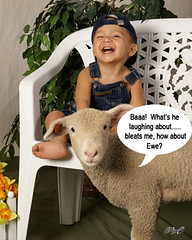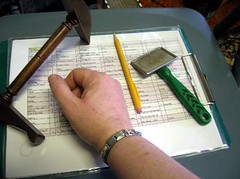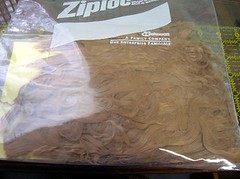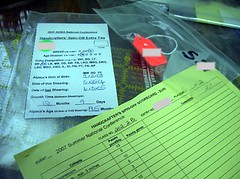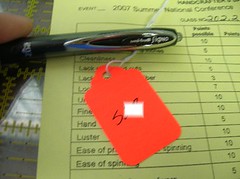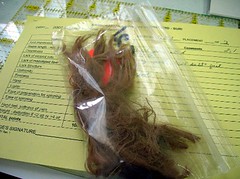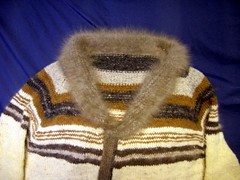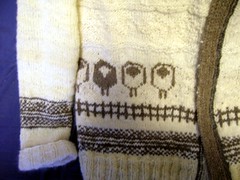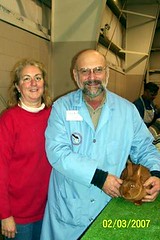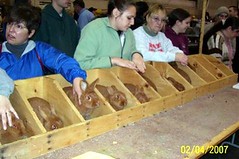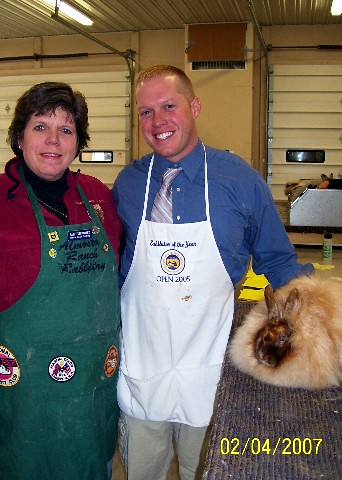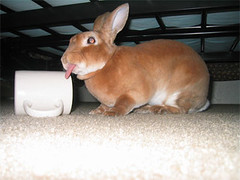
Thursday, May 03, 2007
Wednesday, May 02, 2007
Please define: ILLEGAL
Dobbs: A peculiar day for immigration rallies
POSTED: 8:52 a.m. EDT, May 2, 2007
By Lou DobbsCNN
Editor's Note: Lou Dobbs' commentary appears weekly on CNN.com.
NEW YORK (CNN) -- What a spectacle, what a mess. What a day for thousands and thousands of illegal aliens and their supporters to march through the streets of many of our biggest cities demanding amnesty for illegally entering the country.
Tuesday was given over to illegal aliens and their supporters to demand forgiveness for using fraudulent documents and assisting others in entering this country illegally. What a day for illegal aliens and their supporters to demand not only amnesty but also the end to immigration raids and an end to deportations.
May Day was a peculiar choice for those demonstrations, a day in many countries in which international socialism is celebrated and a reminder of those old Soviet Union military parades.
It was also an unfortunate and ironic choice on the part of the organizers of the demonstrations. May 1 in the United States is actually Law Day, a day first established by President Eisenhower in 1958 and ultimately codified into law in 1961 at the beginning of John F. Kennedy's administration. The purpose of Law Day is to give all Americans an opportunity to reflect on our legal heritage, and by statute, encourages "the cultivation of the respect for law that is so vital to the democratic way of life."
I'll bet you know about the illegal alien amnesty marches, but I don't know of a single news organization, electronic or print that pointed out that May 1 is America's Law Day. The cable news networks gave almost wall-to-wall coverage to the illegal alien demonstrations, but they apparently couldn't find any American celebrating Law Day.
And no one seems to want to take note that we are first a nation of laws, and that without those laws and their enforcement, the foundation of our great republic turns to sand. What a spectacle on Law Day for demonstrators to demand amnesty for those who broke the law to enter our country, many of whom also broke the law with fraudulent documents.
And what a mess when the president of the United States and the U.S. Congress are pandering to a group of people who are not citizens and refuse to demand enforcement of our immigration laws, our criminal laws, and fails to secure our borders and ports.
I couldn't help but wonder as I watched monitors bringing images of the marches and demonstrations from all across the country, who should really be protesting on May Day. What about the millions of legal residents who followed the long, drawn-out process to secure a visa to enter the United States lawfully? Maybe they should be protesting. What about the seven-figure backlog at the Citizenship and Immigration Services agency of people who are following the rules. Should they demonstrate?
What about all of our fellow Americans who are being marginalized by the massive importation of illegal, low-cost and mostly uneducated labor into this country? Perhaps those citizens should take to the streets. And what about the more than 250 million Americans who make up our middle class and those who aspire to it whose wages have stagnated and who are paying for the social, medical and economic costs of illegal immigration? That's a big march.
If yesterday's demonstrators and their supporters in Congress and corporate America are serious about their deep desire for American citizenship, why don't we hear any of them clearly say they're willing to give up dual citizenship? Or that they're willing to learn English and surrender demands of bilingual education? Or declare they embrace English as our official national language? Or demand that illegal employers of illegal aliens pay for the social, educational and medical costs now borne by the taxpayers?
Yesterday was Law Day. I hope that we celebrate Law Day with a great national enthusiasm next May 1. I guarantee you I'll march in that demonstration.
The opinions expressed in this commentary are solely those of the writer.
Saturday, April 28, 2007
Friday, April 20, 2007
getting there..
Monday, April 16, 2007
Sunday, April 08, 2007
Saturday, April 07, 2007
Happy Easter!
Sunday, April 01, 2007
Hancrafter's spin off, Spinning
Basically, each sample needs to be evaluated for it's actual PERFORMANCE in the hands of a spinner. The resulting yarn quality will be evaluated in the final step.
Tools of the trade: The spinning wheel. Now, any wheel can work, but this is my preference. I
 use an Ashford Elizabeth 2 Saxony style wheel set on single drive with Scotch tension. The reason I like this wheel in particular is that it has so many possible variations. It can be used double drive, single drive with Scotch tension (pictured), or direct drive. I choose SD with Scotch tension for this application because it allows me to fine tune and fine FEEL what is happening in the fiber. It also allows me to very quickly remove the tension completely so that I can wind the skeins.
use an Ashford Elizabeth 2 Saxony style wheel set on single drive with Scotch tension. The reason I like this wheel in particular is that it has so many possible variations. It can be used double drive, single drive with Scotch tension (pictured), or direct drive. I choose SD with Scotch tension for this application because it allows me to fine tune and fine FEEL what is happening in the fiber. It also allows me to very quickly remove the tension completely so that I can wind the skeins. Other tools: A small niddy noddy to wind the 4-5 yard lengths into a practical skein for evaluation. Pencil and score sheet obviously. The "flicker brush" is ESSENTIAL to this process. 10 points is assigned to 'preparation of fiber'.
Some people have used a mechanical drum carder to prepare the samples for Spin Off. The first problem here is that it takes at least an ounce of fiber to properly card on a drum carder. I don't NEED to actually work that much fiber in order to judge it adequately so anything over a handful processed is wasted. As far as I'm concerned, the person sending the sample deserves the assumption that their fiber is valuable and should not be treated wastefully. I am not going to spin a full ounce of fiber just because I already carded it and it is plain out WRONG to waste that fiber. The second problem is that you simply cannot compare how one fiber drum cards to how another drum cards. The drum is intended to make ALL fiber easier to work. There simply is no judgement to the process. Alpaca is known for needing minimal processing for use and that means flicking.
The last tool in the photo might be my hand but in reality, it's what is ON my hand; namely the bracelet. I find it essential to my process but that is better shown than explained.
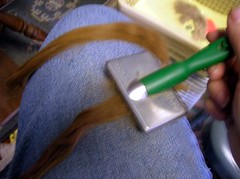
Flicking. The flicker - yes, it is a cheap cat slicker brush and it's served me well for the $3.50 I spent on it 4 or 5 years ago - is bounced, not dragged, over the ends of the fiber. This serves to simply open up the fibers. On really long staples like the suri pictured it takes a patient effort to work from the end to the middle of the staple without breaking and losing the fiber. Fiber that is brittle or tender won't stand the process and ends up wasted. How well the fiber opens up and the amount of loss contribute to the score. I give every staple 3 taps per end. More than that and the points start decreasing. Extremely long fiber may well lose points here, but may gain them right back in the spinning and as a fine yarn later.
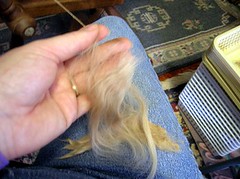
Drafting is an important part of how the fiber is scored for spinning. The best fiber is one that is not so slippery as to resist twist but no so tacky as to resist drafting. A great fiber lends itself to any type of draft I choose; short draw, long draw, spinning from the fold or novelties like slub or boucle. Huacaya fiber almost always drafts evenly from the cut or tip end but suri often spins well only from the tip. Basically, the more the fiber allows me to do, the better it is and the higher the score.
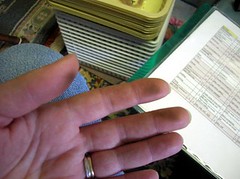
This is an example of what you do NOT want your fiber to do! This fiber was so covered in a black (?!) substance that my hands were covered after spinning just a small handful. The fiber was very sticky and required a lot of work to keep it reasonably smooth and even. This fleece would require washing before any preparation could be done. It's unpleasant and un-versatile. That equals a very poor impression on the customer and a very poor score for the fiber.
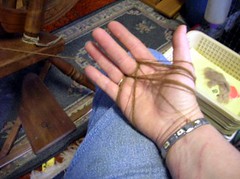
And here is my personal secret to success. After the fiber is spun into a single strand, the tension is released completely and the strand is drawn back out through the orifice. I catch the end of the strand under my bracelet (if I lose that end, I'm skunked!) and then wind the strand around my hand into an Andean bracelet.
Once I reach the far end of the strand, I release the bracelet, meet the near and far ends of the strand (
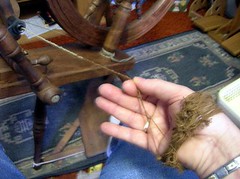 effectively folding the strand in half) and then ply the two ends together into a 2 ply yarn. The strand never leaves the bobbin.
effectively folding the strand in half) and then ply the two ends together into a 2 ply yarn. The strand never leaves the bobbin. 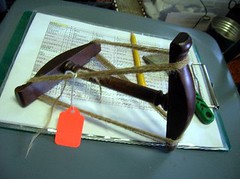 The plied yarn is wound on a Niddy to make one large loop of yarn.
The plied yarn is wound on a Niddy to make one large loop of yarn. 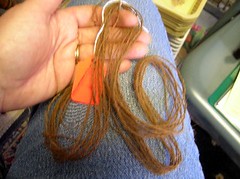
The plied yarn skein can be evaluated for it's performance right off the niddy. Does it balance easily and allow it to lay (lie?) relaxed? Does the fiber resist twist causing slubs and excessive barbing of the fiber?
The next step will be to wash the skeins and then evaluate the finished yarns. The photos of that might take a few days since I can't for the life of me find my battery charger. It's here someplace.
Friday, March 30, 2007
Tuesday, March 20, 2007
Just showing off a little
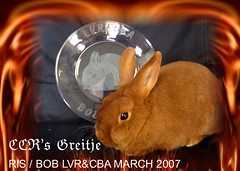 I attended the Lehigh Valley Rabbit Breeders (LVR&CBA) show in Hamburg PA this past Saturday. We had about 12 inches of snow the day before so I wasn't real keen on taking a whole slew of rabbits, but Thriantas are so easy so I took 2 bucks and a doe. It was a double show and the same doe, CCR's Greitje, took BOB both shows! Even better, she took
I attended the Lehigh Valley Rabbit Breeders (LVR&CBA) show in Hamburg PA this past Saturday. We had about 12 inches of snow the day before so I wasn't real keen on taking a whole slew of rabbits, but Thriantas are so easy so I took 2 bucks and a doe. It was a double show and the same doe, CCR's Greitje, took BOB both shows! Even better, she took RESERVE IN SHOW in Show B! Judge Paul Kyle awarded her the BOB and Judge John Soper awarded her the RIS. Judge RuthAnn Bell awarded her BOB in show A. There were between 1200 and 1500 entries and the show was sanctioned with the ATRBA. Yah!
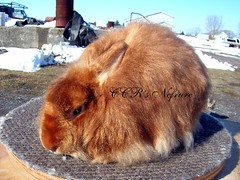 Not to be outdone back at home, CCR's Nefrure a Red Satin Angora Sr Doe wanted to show that Thriantas aren't the only fireballs around here. Gotta love RED.
Not to be outdone back at home, CCR's Nefrure a Red Satin Angora Sr Doe wanted to show that Thriantas aren't the only fireballs around here. Gotta love RED.
Monday, March 12, 2007
Alpaca judging step 2
 The first Judging criteria is First Impression. I look at the packaged sample before ever touching it. Is it presented well? Was time and care taken in selecting and preparing the sample? Is the fiber in good condition; not dirty, matted or messy? Can I easily sort the fiber for spinning? This is one step that can make or break a contest. ALL fiber can be presented well or poorly and that is the FIRST impression you make to your buyer! Mediocre fiber will sell for more if it is presented well and outstanding fiber will sell for less if you look like you couldn't care less how you treat your customer. There is simply no excuse for jamming a random sample in a bag and expecting people to pay top dollar.
The first Judging criteria is First Impression. I look at the packaged sample before ever touching it. Is it presented well? Was time and care taken in selecting and preparing the sample? Is the fiber in good condition; not dirty, matted or messy? Can I easily sort the fiber for spinning? This is one step that can make or break a contest. ALL fiber can be presented well or poorly and that is the FIRST impression you make to your buyer! Mediocre fiber will sell for more if it is presented well and outstanding fiber will sell for less if you look like you couldn't care less how you treat your customer. There is simply no excuse for jamming a random sample in a bag and expecting people to pay top dollar. 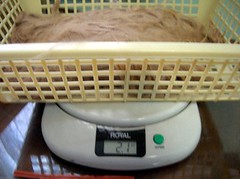 Every sample is weighed. Was the correct amount of fiber sent? If you sent less, did you overcharge me? If more, did you charge me for more than I asked?
Every sample is weighed. Was the correct amount of fiber sent? If you sent less, did you overcharge me? If more, did you charge me for more than I asked? 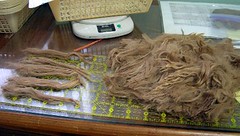 Points are also given for staple length with a minimum of 3 inches required. 5-7 locks are chosen from all over the sample. There are no extra points for a particular length of staple, but are the lengths CONSISTENT? It's rare to find all staples exactly the same but they should be very, very close. Points are deducted based on percentage of difference. a 1 inch difference between 3 and 4 inches is much more severe than between 11 and 12 inches. A very important evaluation is for fiber that is sound and has no tender breaks or weak tips. Either of these things can ruin an entire fleece by creating noils and pills in the resulting yarn.
Points are also given for staple length with a minimum of 3 inches required. 5-7 locks are chosen from all over the sample. There are no extra points for a particular length of staple, but are the lengths CONSISTENT? It's rare to find all staples exactly the same but they should be very, very close. Points are deducted based on percentage of difference. a 1 inch difference between 3 and 4 inches is much more severe than between 11 and 12 inches. A very important evaluation is for fiber that is sound and has no tender breaks or weak tips. Either of these things can ruin an entire fleece by creating noils and pills in the resulting yarn. 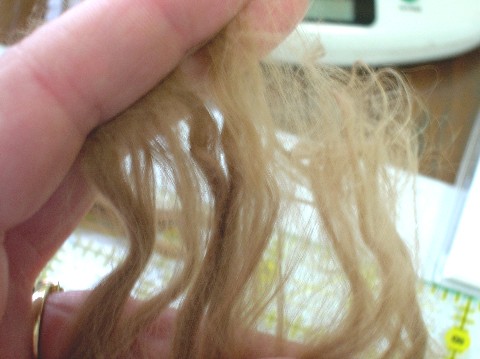
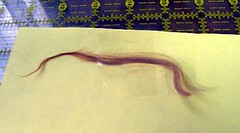
Friday, March 09, 2007
Thursday, March 08, 2007
Judging Alpaca
I'm going to try to post periodic updates about the judging process and what goes into this awesome job of mine. Now, I have to be totally honest here; much of this will probably be about my own neurotic ways and opinions, both of which I have in excess. :)
OK, the first step: Receiving the samples.
Th
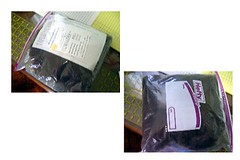 is is the first step for ME, but by no means the first step in the process. Before the samples arrive at my doorstep, they are received and processed by the supervisor of this particular contest. She receives the sample from the exhibitor, she checks the information for accuracy and completeness. The exhibitor lists the age of the animal in years and months, they list the number of months the sample fiber has been growing and the date of the last shearing. The color classification is checked against the AOBA show standard and they will attempt to eliminate any really flagrant disqualifications such as infestation. The supervisor will then remove ALL identifying material from the sample so that I - the judge - has no way of knowing who sent in the entry. Entry numbers are assigned, and judging forms are filled out and included in the sample entry bag. Then the entries are sorted into classes, packed into boxes and mailed to me.
is is the first step for ME, but by no means the first step in the process. Before the samples arrive at my doorstep, they are received and processed by the supervisor of this particular contest. She receives the sample from the exhibitor, she checks the information for accuracy and completeness. The exhibitor lists the age of the animal in years and months, they list the number of months the sample fiber has been growing and the date of the last shearing. The color classification is checked against the AOBA show standard and they will attempt to eliminate any really flagrant disqualifications such as infestation. The supervisor will then remove ALL identifying material from the sample so that I - the judge - has no way of knowing who sent in the entry. Entry numbers are assigned, and judging forms are filled out and included in the sample entry bag. Then the entries are sorted into classes, packed into boxes and mailed to me.Now the Postal Lady delivers them to Me!!!
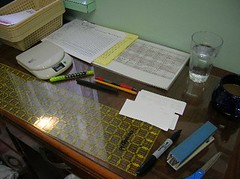
And here is my first obsession. I have very specific tools I need and I have to have just the right stuff.
*Scale to weigh every sample in ounces (2 oz is the requirement)
*Pencil to record ongoing scores on the judging sheet - I have ONE style of mechanical pencil I'll use. The yellow Bic pencil with the cone that turns. I don't like the clicker style. I tore the house apart before I found ONE pencil to my satisfaction and then it was nearly empty. That required a trip to WalMart.
*felt marker to mark plastic bags
*Paper labels and stapler to re-label bags to my satisfaction
*Highlighter and red pen to remind me of things I need to remember about my scoring.
*Coffee - that doesn't really need explanation does it?
*Bins for sorting classes
*Detail judging score outlines. I literally assign specific score numbers to various traits. This is the best way I know to judge OBJECTIVELY when appropriate.
*Clear ruler to measure staple length of every sample entry.
Now, do I sound like I want things to be 'just so'? That would be correct, so what do I see when I open the boxes?
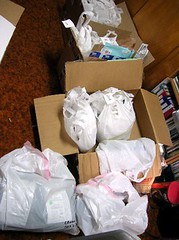

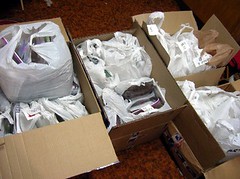
HAPPY BIRTHDAY CITH!!!

Monday, March 05, 2007
Roasted with thyme please...
So I went to a nice rabbit show this weekend in York PA. Good show! Good judges, lots of nice people and a dear friend won BIS with a really GORGEOUS black New Zealand. Not a variety/breed known for such high quality so that was a real accomplishment! Big Congrats Fred!
Things were going just fine and I was having a nice visit with other friends Eric and Michael. They had their dogs with them. First I saw the darling Papillon running around and I just love those guys. They are one of those breeds that don't realize that they are only 18 inches tall. Then out runs Eric's two prize dogs and I exclaimed "Oh, I just LOVE min-pins!" (which I thought I did) A-hem.... they are Manchesters. Lesson #1 in offending your friends down to the heart: Mistake their high quality show dogs for the WRONG BREED. Works every time. I was MORTIFIED! It's ok, I'm accustomed to humiliation as I have a long-standing relationship with it based on familiarity. ugh.
OK, so my new favorite is MANCHESTER TERRIERS! Honestly, they really do have exactly the look I thought I loved about the min-pins and Eric's were fine examples. Very nice dogs.
So if you'll excuse me, I need some whine (sic) to wash down that crow. :)
Oh, I'm not reporting any show wins because I didn't take so much as the first rabbit along with me. Yeah. Imagine that. I went to a rabbit show just to visit, write for judges and study breeds. I really did have a good time!
Thursday, February 22, 2007
Sunday, February 18, 2007
A personal challenge
But when a long train of abuses and usurpation, pursuing invariably the same
Object evinces a design to reduce them under absolute Despotism, it is their
right, it is their duty, to throw off such Government, and to provide new Guards
for their future security....Declaration of Independence
Imagine there's no countries.. It isn't hard to do.. Nothing to kill or die
for. And no religion too.. Imagine all the people.. Living life in
peace...You may say I'm a dreamer.. But I'm not the only one.. I hope someday you'll
join us.. And the world will be as one....John Lennon
I had cause this weekend to hear both these texts, completely unrelated, but in close enough proximity to get me to thinking. Both texts were overlaying thoughts that I had about this book
The premise of this philosophy is that we create, through our own beliefs, actions, thoughts and personal energy the life we live. WE can change the direction of our lives by owning and accepting the responsibility for those same energies. It's what every religion has ever taught. Faith. Belief. Prayer. Possitive action. Non resistant protest.
The first quote says to me that "when any authority over us imposes abuses upon people, it is not only the right, but the RESPONSIBILITY of those who are able, to take action".
The second quote tells me that reaching for PEACE is an assertive and goal oriented action. Imagine...IMAGINE. What is it to imagine, if not actively creating a reality?
Our country is currently telling us we are in a war against terrorism. I assert to you that if we accept that we must war against them, then they have already won. They have already dictated what our action will be? Really?
Does this mean that I am anti war? yes. Am I anti Military service, anti service in Iraq, Afghanistan, Bosnia... absolutely not. I support our troops more than ever but I choose to pray that they will protect, liberate and open doors of opportunity for the civilians in those areas that they don't even realize are possibilities in their cultures of oppression.
Where will we as a people direct the energy of our actions, beliefs and PRAYERS? Toward fighting, or toward working for PEACE. I will not FEAR - I will practice bravery. I will not HATE - I will practice unconditional love. I will not COMPETE - I will lift up others that I will also rise to their new level. I will not just FORGIVE - I will thank others FOR GIVING me that experience.
What will you do?
Saturday, February 10, 2007
Fibery stuff
 First, to put Judy's mind to rest, here is the repaired Bunny Sweater. For those who aren't so familiar with this one, the dark is cria (baby) huacaya alpaca and each of the colored stripes is from a special rabbit or alpaca I've owned or worked with. My very first 2 Satin angoras are represented there along with my red SA herd-buck Zahir on the collar. It certainly is a sweater worth repairing to me.
First, to put Judy's mind to rest, here is the repaired Bunny Sweater. For those who aren't so familiar with this one, the dark is cria (baby) huacaya alpaca and each of the colored stripes is from a special rabbit or alpaca I've owned or worked with. My very first 2 Satin angoras are represented there along with my red SA herd-buck Zahir on the collar. It certainly is a sweater worth repairing to me. 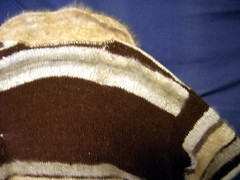
This is the back where the majority of damage was done. I think the re-weaving looks pretty darned good. I couldn't use the exact yarn so there is some color difference but with all that fluff.. Now the alpaca parts match better because I actually did find some leftover yarn. How's that for luck? I have to thank one reader for the excellent idea to full the sweater. I didn't' have to resort to cutting the sweater apart but fulling the entire thing really stabilized it and I think, made it a better sweater. Had I done that in the beginning, it might not have ended up so lonnnnnnnnngggggg. :)
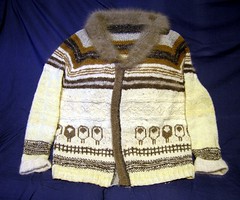
I just love this thing. You might notice the different shades of natural white and if you could really see up close you'd see that the textures are quite different too. This was knitted using skeins of yarn spun at demos over the past years. Who knows what breeds of sheep those came from or where or when. Do I care? Not one whit. There is history in that sweater and I love that. I had planned to put more bunny designs and more angora in the yoke but as it progressed, it just didn't' seem right somehow. I really like the bands of color as they are.
So that's my fibery exploits the past couple of weeks. I've also been knitting up some smaller stuff like barn caps and fingerless mitts just to use up more of this demo yarn but they really don't merit photos. They are warm and functional, but not so pretty.
Tomorrow, Photos from the Wool, Skein and Garment contest at the PAngora rabbit show last weekend.
Thursday, February 08, 2007
PaSRBA Convention Report

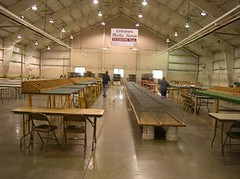 wn is the PaSRBA Rabbit Convention the first weekend of February. What a fantastic weekend it was!
wn is the PaSRBA Rabbit Convention the first weekend of February. What a fantastic weekend it was! Now, in the all breed room this means enough space for carriers and people and maybe a few chairs for people who can't stand 8 hours at a time. In the wool room, this means carriers of rabbits, people, grooming tables, blowers, electrical outlets for those blowers, chairs for all the exhibitors and room for tack boxes and grooming equipment. These things are not accessories to wool breed exhibitors; they are essentials. Of course in the wool room I only had 4 judges and 500 or so rabbits and no vendors as opposed to 6000 rabbits, 28 judges and vendors. Brian Bell has my awe as well as my respect!
Now, in the all breed room this means enough space for carriers and people and maybe a few chairs for people who can't stand 8 hours at a time. In the wool room, this means carriers of rabbits, people, grooming tables, blowers, electrical outlets for those blowers, chairs for all the exhibitors and room for tack boxes and grooming equipment. These things are not accessories to wool breed exhibitors; they are essentials. Of course in the wool room I only had 4 judges and 500 or so rabbits and no vendors as opposed to 6000 rabbits, 28 judges and vendors. Brian Bell has my awe as well as my respect!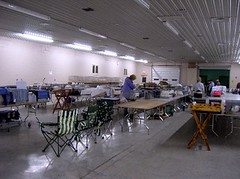 and breeders started coming in, most of the work was done, right? Not even close! There were the 100+ entries of Lionhead rabbits to account for. As a non-recognized breed one doesn't expect such high numbers but there they were and they were certainly welcome. The challenge for the LHs wasn't just the numbers but the fact that the vast majority of LH owners have no ARBA show experience. We want to make these folks welcome and that includes introducing them to everything we do from what sort of carriers are appropriate to where and how to set up their areas to how to write for the judges. Saturday was a bit hectic but they caught on quickly and Sunday was much more efficient. Thanks to Tori Whitehause for her tremendous help on Saturday teaching writters. Thank you to everyone for welcoming these new friends to our ARBA family. I'm really sorry I didn't get photos of some of those winning rabbits. Very pretty!
and breeders started coming in, most of the work was done, right? Not even close! There were the 100+ entries of Lionhead rabbits to account for. As a non-recognized breed one doesn't expect such high numbers but there they were and they were certainly welcome. The challenge for the LHs wasn't just the numbers but the fact that the vast majority of LH owners have no ARBA show experience. We want to make these folks welcome and that includes introducing them to everything we do from what sort of carriers are appropriate to where and how to set up their areas to how to write for the judges. Saturday was a bit hectic but they caught on quickly and Sunday was much more efficient. Thanks to Tori Whitehause for her tremendous help on Saturday teaching writters. Thank you to everyone for welcoming these new friends to our ARBA family. I'm really sorry I didn't get photos of some of those winning rabbits. Very pretty! 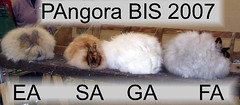
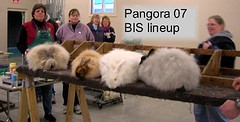

 OK, I was trying to get a better photo of the Sable FA and the EA but I got Eric's hindquarter instead. We decided to name him BIS hindquarter. hehehehehehhe Eric was totally impressed by all the BOB winners and actually stepped aside to suggest that anyone with a camera take photos of these outstanding examples of their breeds. I LOVE. LOVE. LOVE. the Satin Angora. Kathy has done a wonderful job with that rabbits breeding and care. But I have to profess a serious lust for that Sable French Angora bred and owned by Amy Spang. The color is gorgous and the coat is MAGNIFICENT. The texture and density are to die for.
OK, I was trying to get a better photo of the Sable FA and the EA but I got Eric's hindquarter instead. We decided to name him BIS hindquarter. hehehehehehhe Eric was totally impressed by all the BOB winners and actually stepped aside to suggest that anyone with a camera take photos of these outstanding examples of their breeds. I LOVE. LOVE. LOVE. the Satin Angora. Kathy has done a wonderful job with that rabbits breeding and care. But I have to profess a serious lust for that Sable French Angora bred and owned by Amy Spang. The color is gorgous and the coat is MAGNIFICENT. The texture and density are to die for. 

